Sustainable Tourism Business in Australia
VerifiedAdded on 2023/06/03
|9
|1920
|382
AI Summary
This article provides an insight into sustainable tourism practices in Australia, including policies, strategies, impact on the environment and stakeholders. It explains the objectives, stakeholders, phenomenon, operation and performance outcome of sustainable tourism in Australia.
Contribute Materials
Your contribution can guide someone’s learning journey. Share your
documents today.

Running Head: Sustainable Tourism Business
Sustainable Tourism Business in
Australia
October 12
2018
Article for HBR
Sustainable Tourism Business in
Australia
October 12
2018
Article for HBR
Secure Best Marks with AI Grader
Need help grading? Try our AI Grader for instant feedback on your assignments.
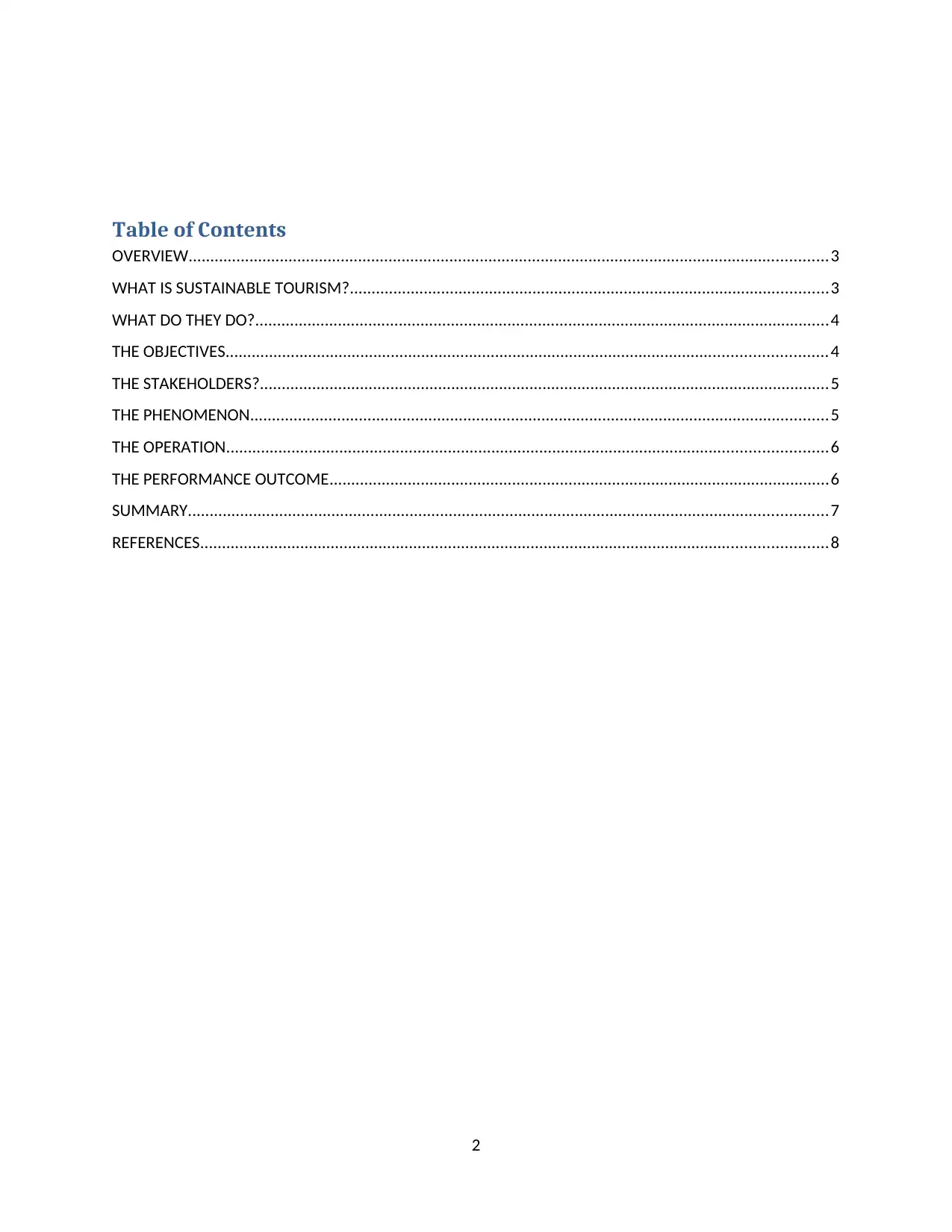
Table of Contents
OVERVIEW...................................................................................................................................................3
WHAT IS SUSTAINABLE TOURISM?..............................................................................................................3
WHAT DO THEY DO?....................................................................................................................................4
THE OBJECTIVES..........................................................................................................................................4
THE STAKEHOLDERS?...................................................................................................................................5
THE PHENOMENON.....................................................................................................................................5
THE OPERATION..........................................................................................................................................6
THE PERFORMANCE OUTCOME...................................................................................................................6
SUMMARY...................................................................................................................................................7
REFERENCES................................................................................................................................................8
2
OVERVIEW...................................................................................................................................................3
WHAT IS SUSTAINABLE TOURISM?..............................................................................................................3
WHAT DO THEY DO?....................................................................................................................................4
THE OBJECTIVES..........................................................................................................................................4
THE STAKEHOLDERS?...................................................................................................................................5
THE PHENOMENON.....................................................................................................................................5
THE OPERATION..........................................................................................................................................6
THE PERFORMANCE OUTCOME...................................................................................................................6
SUMMARY...................................................................................................................................................7
REFERENCES................................................................................................................................................8
2
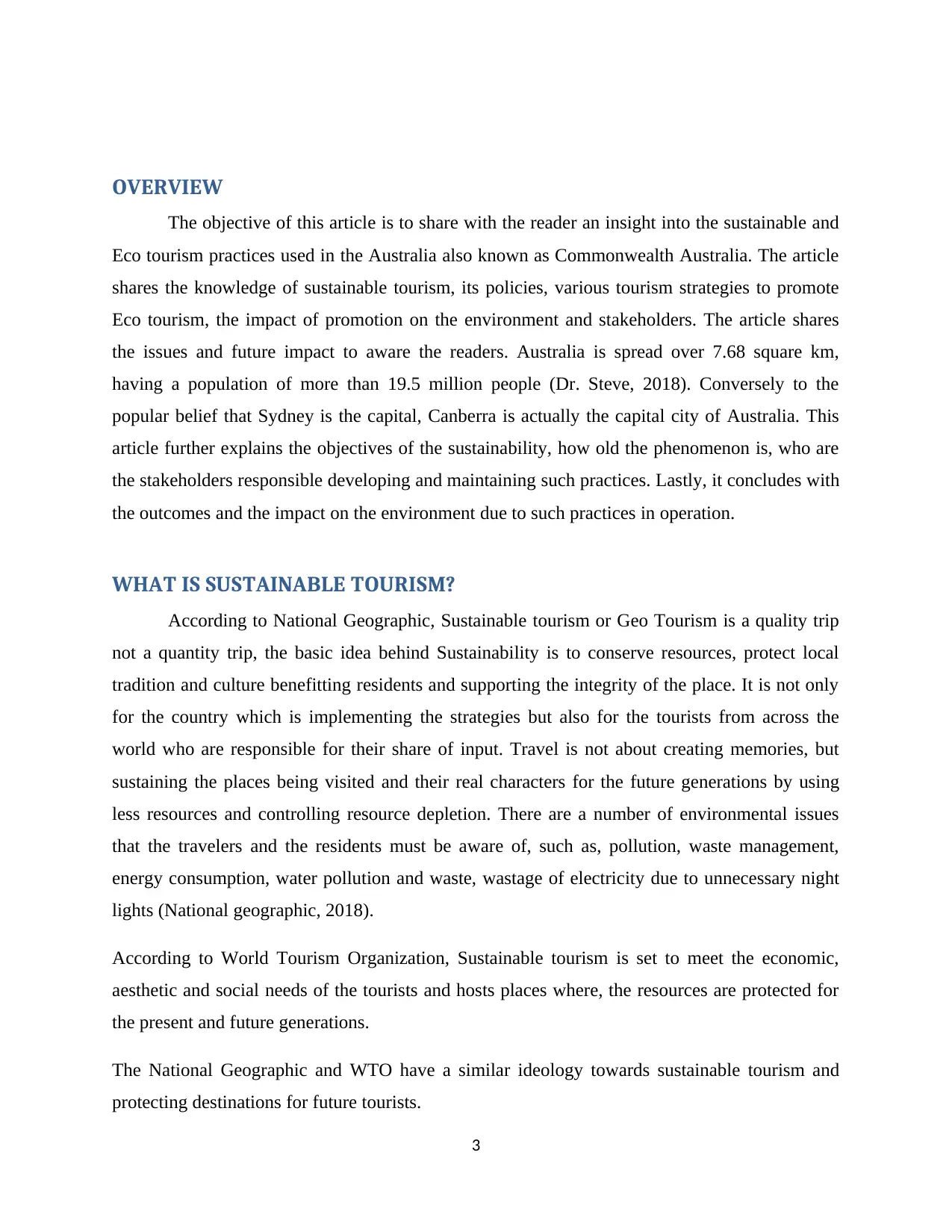
OVERVIEW
The objective of this article is to share with the reader an insight into the sustainable and
Eco tourism practices used in the Australia also known as Commonwealth Australia. The article
shares the knowledge of sustainable tourism, its policies, various tourism strategies to promote
Eco tourism, the impact of promotion on the environment and stakeholders. The article shares
the issues and future impact to aware the readers. Australia is spread over 7.68 square km,
having a population of more than 19.5 million people (Dr. Steve, 2018). Conversely to the
popular belief that Sydney is the capital, Canberra is actually the capital city of Australia. This
article further explains the objectives of the sustainability, how old the phenomenon is, who are
the stakeholders responsible developing and maintaining such practices. Lastly, it concludes with
the outcomes and the impact on the environment due to such practices in operation.
WHAT IS SUSTAINABLE TOURISM?
According to National Geographic, Sustainable tourism or Geo Tourism is a quality trip
not a quantity trip, the basic idea behind Sustainability is to conserve resources, protect local
tradition and culture benefitting residents and supporting the integrity of the place. It is not only
for the country which is implementing the strategies but also for the tourists from across the
world who are responsible for their share of input. Travel is not about creating memories, but
sustaining the places being visited and their real characters for the future generations by using
less resources and controlling resource depletion. There are a number of environmental issues
that the travelers and the residents must be aware of, such as, pollution, waste management,
energy consumption, water pollution and waste, wastage of electricity due to unnecessary night
lights (National geographic, 2018).
According to World Tourism Organization, Sustainable tourism is set to meet the economic,
aesthetic and social needs of the tourists and hosts places where, the resources are protected for
the present and future generations.
The National Geographic and WTO have a similar ideology towards sustainable tourism and
protecting destinations for future tourists.
3
The objective of this article is to share with the reader an insight into the sustainable and
Eco tourism practices used in the Australia also known as Commonwealth Australia. The article
shares the knowledge of sustainable tourism, its policies, various tourism strategies to promote
Eco tourism, the impact of promotion on the environment and stakeholders. The article shares
the issues and future impact to aware the readers. Australia is spread over 7.68 square km,
having a population of more than 19.5 million people (Dr. Steve, 2018). Conversely to the
popular belief that Sydney is the capital, Canberra is actually the capital city of Australia. This
article further explains the objectives of the sustainability, how old the phenomenon is, who are
the stakeholders responsible developing and maintaining such practices. Lastly, it concludes with
the outcomes and the impact on the environment due to such practices in operation.
WHAT IS SUSTAINABLE TOURISM?
According to National Geographic, Sustainable tourism or Geo Tourism is a quality trip
not a quantity trip, the basic idea behind Sustainability is to conserve resources, protect local
tradition and culture benefitting residents and supporting the integrity of the place. It is not only
for the country which is implementing the strategies but also for the tourists from across the
world who are responsible for their share of input. Travel is not about creating memories, but
sustaining the places being visited and their real characters for the future generations by using
less resources and controlling resource depletion. There are a number of environmental issues
that the travelers and the residents must be aware of, such as, pollution, waste management,
energy consumption, water pollution and waste, wastage of electricity due to unnecessary night
lights (National geographic, 2018).
According to World Tourism Organization, Sustainable tourism is set to meet the economic,
aesthetic and social needs of the tourists and hosts places where, the resources are protected for
the present and future generations.
The National Geographic and WTO have a similar ideology towards sustainable tourism and
protecting destinations for future tourists.
3
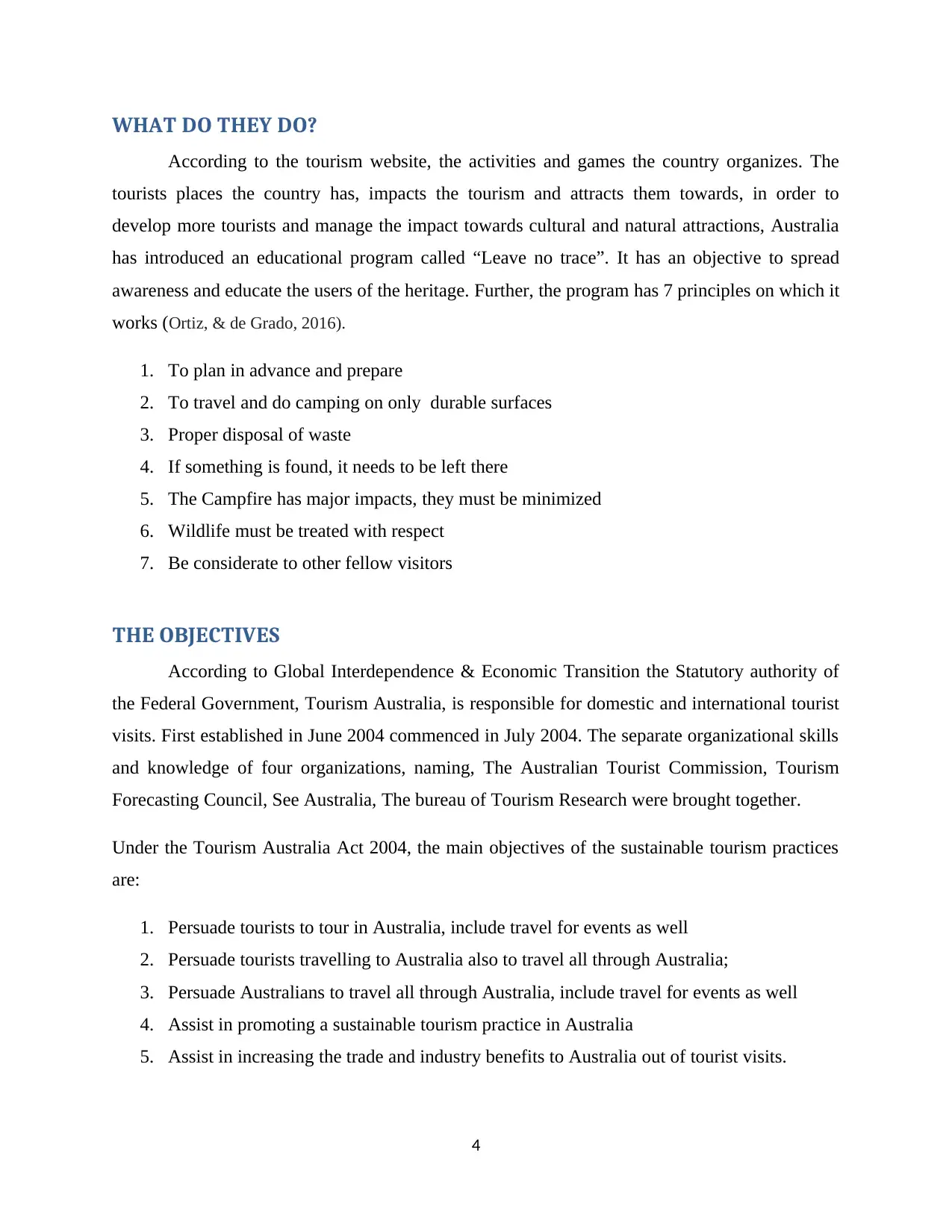
WHAT DO THEY DO?
According to the tourism website, the activities and games the country organizes. The
tourists places the country has, impacts the tourism and attracts them towards, in order to
develop more tourists and manage the impact towards cultural and natural attractions, Australia
has introduced an educational program called “Leave no trace”. It has an objective to spread
awareness and educate the users of the heritage. Further, the program has 7 principles on which it
works (Ortiz, & de Grado, 2016).
1. To plan in advance and prepare
2. To travel and do camping on only durable surfaces
3. Proper disposal of waste
4. If something is found, it needs to be left there
5. The Campfire has major impacts, they must be minimized
6. Wildlife must be treated with respect
7. Be considerate to other fellow visitors
THE OBJECTIVES
According to Global Interdependence & Economic Transition the Statutory authority of
the Federal Government, Tourism Australia, is responsible for domestic and international tourist
visits. First established in June 2004 commenced in July 2004. The separate organizational skills
and knowledge of four organizations, naming, The Australian Tourist Commission, Tourism
Forecasting Council, See Australia, The bureau of Tourism Research were brought together.
Under the Tourism Australia Act 2004, the main objectives of the sustainable tourism practices
are:
1. Persuade tourists to tour in Australia, include travel for events as well
2. Persuade tourists travelling to Australia also to travel all through Australia;
3. Persuade Australians to travel all through Australia, include travel for events as well
4. Assist in promoting a sustainable tourism practice in Australia
5. Assist in increasing the trade and industry benefits to Australia out of tourist visits.
4
According to the tourism website, the activities and games the country organizes. The
tourists places the country has, impacts the tourism and attracts them towards, in order to
develop more tourists and manage the impact towards cultural and natural attractions, Australia
has introduced an educational program called “Leave no trace”. It has an objective to spread
awareness and educate the users of the heritage. Further, the program has 7 principles on which it
works (Ortiz, & de Grado, 2016).
1. To plan in advance and prepare
2. To travel and do camping on only durable surfaces
3. Proper disposal of waste
4. If something is found, it needs to be left there
5. The Campfire has major impacts, they must be minimized
6. Wildlife must be treated with respect
7. Be considerate to other fellow visitors
THE OBJECTIVES
According to Global Interdependence & Economic Transition the Statutory authority of
the Federal Government, Tourism Australia, is responsible for domestic and international tourist
visits. First established in June 2004 commenced in July 2004. The separate organizational skills
and knowledge of four organizations, naming, The Australian Tourist Commission, Tourism
Forecasting Council, See Australia, The bureau of Tourism Research were brought together.
Under the Tourism Australia Act 2004, the main objectives of the sustainable tourism practices
are:
1. Persuade tourists to tour in Australia, include travel for events as well
2. Persuade tourists travelling to Australia also to travel all through Australia;
3. Persuade Australians to travel all through Australia, include travel for events as well
4. Assist in promoting a sustainable tourism practice in Australia
5. Assist in increasing the trade and industry benefits to Australia out of tourist visits.
4
Secure Best Marks with AI Grader
Need help grading? Try our AI Grader for instant feedback on your assignments.
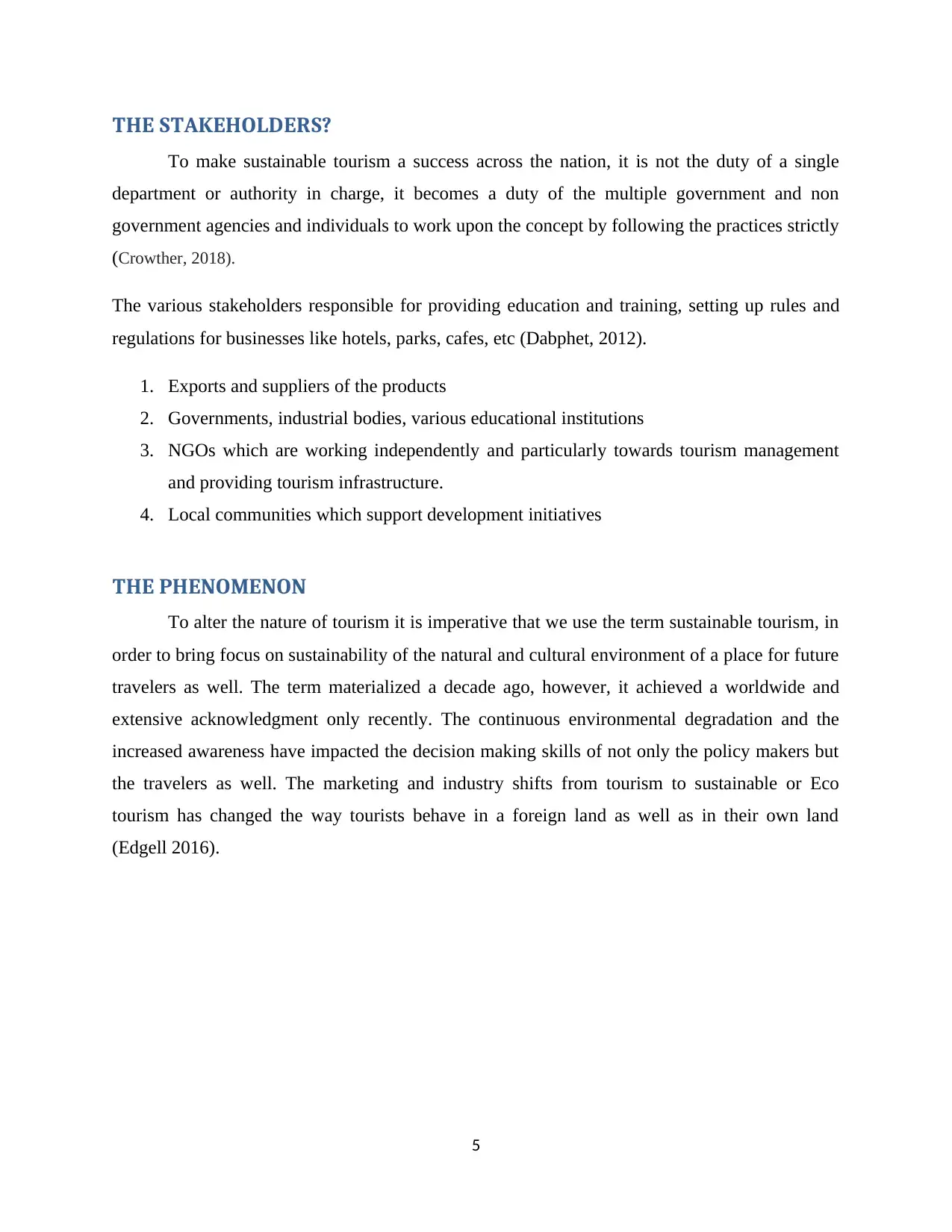
THE STAKEHOLDERS?
To make sustainable tourism a success across the nation, it is not the duty of a single
department or authority in charge, it becomes a duty of the multiple government and non
government agencies and individuals to work upon the concept by following the practices strictly
(Crowther, 2018).
The various stakeholders responsible for providing education and training, setting up rules and
regulations for businesses like hotels, parks, cafes, etc (Dabphet, 2012).
1. Exports and suppliers of the products
2. Governments, industrial bodies, various educational institutions
3. NGOs which are working independently and particularly towards tourism management
and providing tourism infrastructure.
4. Local communities which support development initiatives
THE PHENOMENON
To alter the nature of tourism it is imperative that we use the term sustainable tourism, in
order to bring focus on sustainability of the natural and cultural environment of a place for future
travelers as well. The term materialized a decade ago, however, it achieved a worldwide and
extensive acknowledgment only recently. The continuous environmental degradation and the
increased awareness have impacted the decision making skills of not only the policy makers but
the travelers as well. The marketing and industry shifts from tourism to sustainable or Eco
tourism has changed the way tourists behave in a foreign land as well as in their own land
(Edgell 2016).
5
To make sustainable tourism a success across the nation, it is not the duty of a single
department or authority in charge, it becomes a duty of the multiple government and non
government agencies and individuals to work upon the concept by following the practices strictly
(Crowther, 2018).
The various stakeholders responsible for providing education and training, setting up rules and
regulations for businesses like hotels, parks, cafes, etc (Dabphet, 2012).
1. Exports and suppliers of the products
2. Governments, industrial bodies, various educational institutions
3. NGOs which are working independently and particularly towards tourism management
and providing tourism infrastructure.
4. Local communities which support development initiatives
THE PHENOMENON
To alter the nature of tourism it is imperative that we use the term sustainable tourism, in
order to bring focus on sustainability of the natural and cultural environment of a place for future
travelers as well. The term materialized a decade ago, however, it achieved a worldwide and
extensive acknowledgment only recently. The continuous environmental degradation and the
increased awareness have impacted the decision making skills of not only the policy makers but
the travelers as well. The marketing and industry shifts from tourism to sustainable or Eco
tourism has changed the way tourists behave in a foreign land as well as in their own land
(Edgell 2016).
5
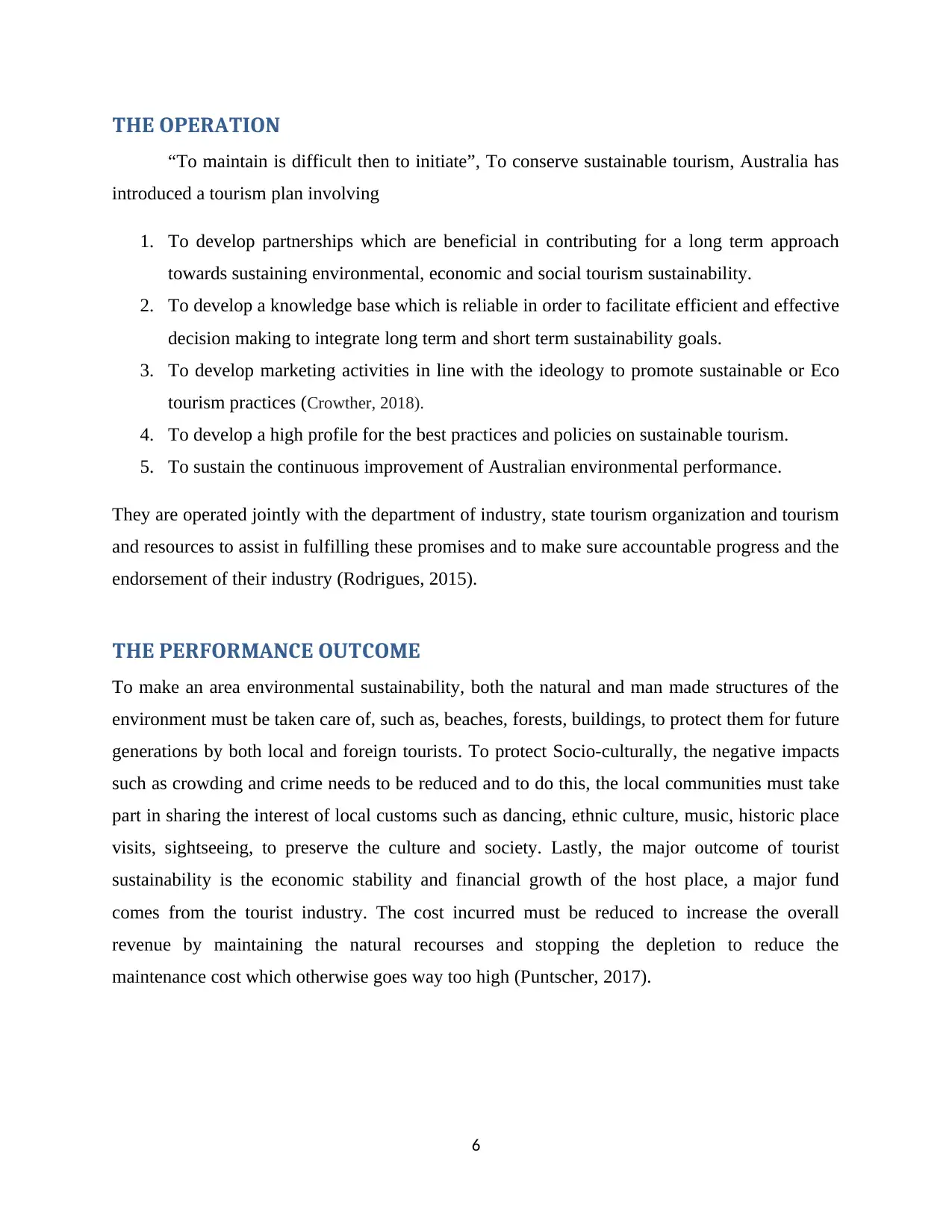
THE OPERATION
“To maintain is difficult then to initiate”, To conserve sustainable tourism, Australia has
introduced a tourism plan involving
1. To develop partnerships which are beneficial in contributing for a long term approach
towards sustaining environmental, economic and social tourism sustainability.
2. To develop a knowledge base which is reliable in order to facilitate efficient and effective
decision making to integrate long term and short term sustainability goals.
3. To develop marketing activities in line with the ideology to promote sustainable or Eco
tourism practices (Crowther, 2018).
4. To develop a high profile for the best practices and policies on sustainable tourism.
5. To sustain the continuous improvement of Australian environmental performance.
They are operated jointly with the department of industry, state tourism organization and tourism
and resources to assist in fulfilling these promises and to make sure accountable progress and the
endorsement of their industry (Rodrigues, 2015).
THE PERFORMANCE OUTCOME
To make an area environmental sustainability, both the natural and man made structures of the
environment must be taken care of, such as, beaches, forests, buildings, to protect them for future
generations by both local and foreign tourists. To protect Socio-culturally, the negative impacts
such as crowding and crime needs to be reduced and to do this, the local communities must take
part in sharing the interest of local customs such as dancing, ethnic culture, music, historic place
visits, sightseeing, to preserve the culture and society. Lastly, the major outcome of tourist
sustainability is the economic stability and financial growth of the host place, a major fund
comes from the tourist industry. The cost incurred must be reduced to increase the overall
revenue by maintaining the natural recourses and stopping the depletion to reduce the
maintenance cost which otherwise goes way too high (Puntscher, 2017).
6
“To maintain is difficult then to initiate”, To conserve sustainable tourism, Australia has
introduced a tourism plan involving
1. To develop partnerships which are beneficial in contributing for a long term approach
towards sustaining environmental, economic and social tourism sustainability.
2. To develop a knowledge base which is reliable in order to facilitate efficient and effective
decision making to integrate long term and short term sustainability goals.
3. To develop marketing activities in line with the ideology to promote sustainable or Eco
tourism practices (Crowther, 2018).
4. To develop a high profile for the best practices and policies on sustainable tourism.
5. To sustain the continuous improvement of Australian environmental performance.
They are operated jointly with the department of industry, state tourism organization and tourism
and resources to assist in fulfilling these promises and to make sure accountable progress and the
endorsement of their industry (Rodrigues, 2015).
THE PERFORMANCE OUTCOME
To make an area environmental sustainability, both the natural and man made structures of the
environment must be taken care of, such as, beaches, forests, buildings, to protect them for future
generations by both local and foreign tourists. To protect Socio-culturally, the negative impacts
such as crowding and crime needs to be reduced and to do this, the local communities must take
part in sharing the interest of local customs such as dancing, ethnic culture, music, historic place
visits, sightseeing, to preserve the culture and society. Lastly, the major outcome of tourist
sustainability is the economic stability and financial growth of the host place, a major fund
comes from the tourist industry. The cost incurred must be reduced to increase the overall
revenue by maintaining the natural recourses and stopping the depletion to reduce the
maintenance cost which otherwise goes way too high (Puntscher, 2017).
6

SUMMARY
Sustainable tourism in Australia has been seen as very successful since they have been
using the plan of action together with the stakeholders. It is important to reduce the impact the
tourists create on the natural environment and degrading it, it is the duty of the travelers while
they are creating memories for themselves, they must maintain the same beauty for their future
generations to allow them to personally enjoy the destinations. Not only environment, but the
man made building and historic places must also be maintained. Australia already has a plan to
carry forward the sustainability, However, they must renew their objectives and plan according
to the need and demand of the environment and stakeholders.
7
Sustainable tourism in Australia has been seen as very successful since they have been
using the plan of action together with the stakeholders. It is important to reduce the impact the
tourists create on the natural environment and degrading it, it is the duty of the travelers while
they are creating memories for themselves, they must maintain the same beauty for their future
generations to allow them to personally enjoy the destinations. Not only environment, but the
man made building and historic places must also be maintained. Australia already has a plan to
carry forward the sustainability, However, they must renew their objectives and plan according
to the need and demand of the environment and stakeholders.
7
Paraphrase This Document
Need a fresh take? Get an instant paraphrase of this document with our AI Paraphraser
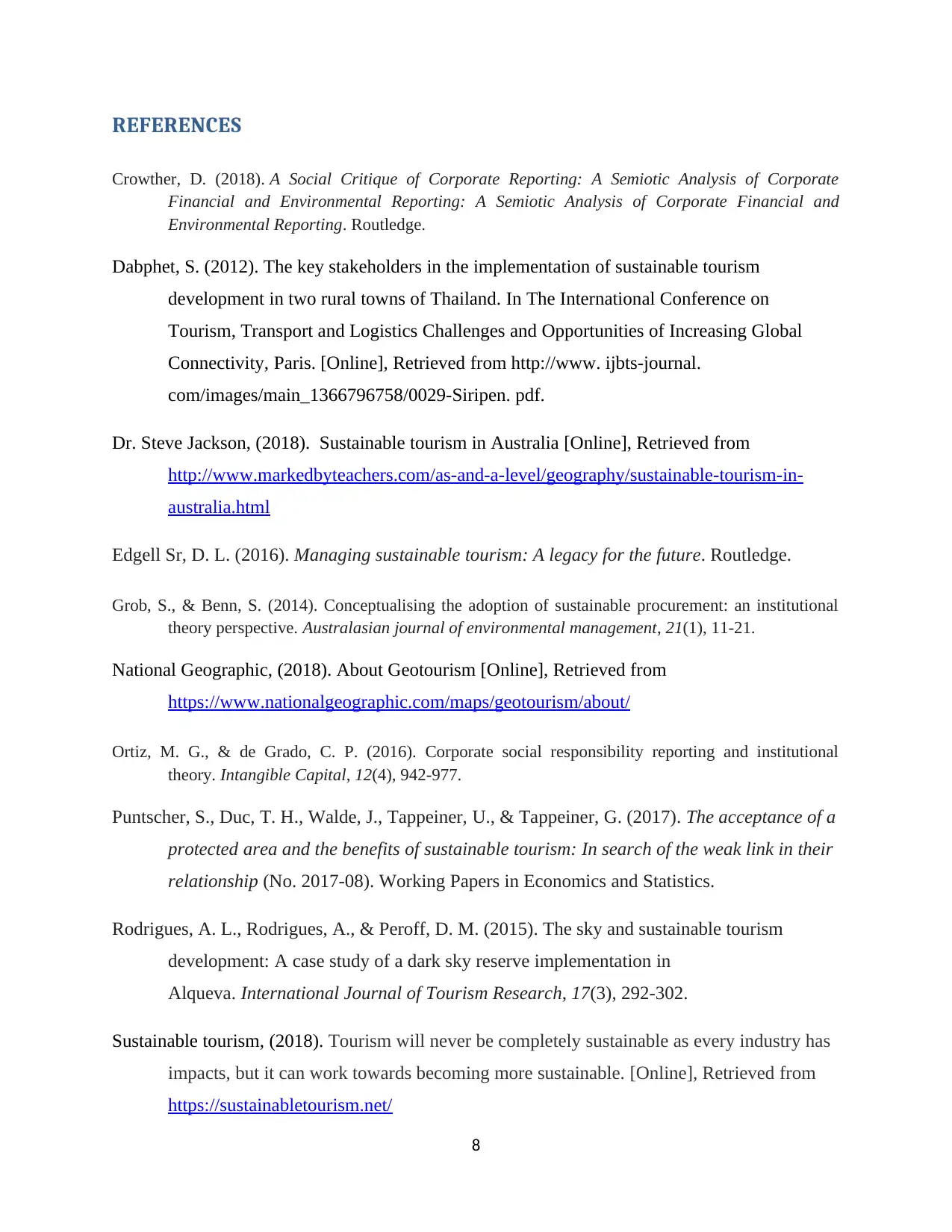
REFERENCES
Crowther, D. (2018). A Social Critique of Corporate Reporting: A Semiotic Analysis of Corporate
Financial and Environmental Reporting: A Semiotic Analysis of Corporate Financial and
Environmental Reporting. Routledge.
Dabphet, S. (2012). The key stakeholders in the implementation of sustainable tourism
development in two rural towns of Thailand. In The International Conference on
Tourism, Transport and Logistics Challenges and Opportunities of Increasing Global
Connectivity, Paris. [Online], Retrieved from http://www. ijbts-journal.
com/images/main_1366796758/0029-Siripen. pdf.
Dr. Steve Jackson, (2018). Sustainable tourism in Australia [Online], Retrieved from
http://www.markedbyteachers.com/as-and-a-level/geography/sustainable-tourism-in-
australia.html
Edgell Sr, D. L. (2016). Managing sustainable tourism: A legacy for the future. Routledge.
Grob, S., & Benn, S. (2014). Conceptualising the adoption of sustainable procurement: an institutional
theory perspective. Australasian journal of environmental management, 21(1), 11-21.
National Geographic, (2018). About Geotourism [Online], Retrieved from
https://www.nationalgeographic.com/maps/geotourism/about/
Ortiz, M. G., & de Grado, C. P. (2016). Corporate social responsibility reporting and institutional
theory. Intangible Capital, 12(4), 942-977.
Puntscher, S., Duc, T. H., Walde, J., Tappeiner, U., & Tappeiner, G. (2017). The acceptance of a
protected area and the benefits of sustainable tourism: In search of the weak link in their
relationship (No. 2017-08). Working Papers in Economics and Statistics.
Rodrigues, A. L., Rodrigues, A., & Peroff, D. M. (2015). The sky and sustainable tourism
development: A case study of a dark sky reserve implementation in
Alqueva. International Journal of Tourism Research, 17(3), 292-302.
Sustainable tourism, (2018). Tourism will never be completely sustainable as every industry has
impacts, but it can work towards becoming more sustainable. [Online], Retrieved from
https://sustainabletourism.net/
8
Crowther, D. (2018). A Social Critique of Corporate Reporting: A Semiotic Analysis of Corporate
Financial and Environmental Reporting: A Semiotic Analysis of Corporate Financial and
Environmental Reporting. Routledge.
Dabphet, S. (2012). The key stakeholders in the implementation of sustainable tourism
development in two rural towns of Thailand. In The International Conference on
Tourism, Transport and Logistics Challenges and Opportunities of Increasing Global
Connectivity, Paris. [Online], Retrieved from http://www. ijbts-journal.
com/images/main_1366796758/0029-Siripen. pdf.
Dr. Steve Jackson, (2018). Sustainable tourism in Australia [Online], Retrieved from
http://www.markedbyteachers.com/as-and-a-level/geography/sustainable-tourism-in-
australia.html
Edgell Sr, D. L. (2016). Managing sustainable tourism: A legacy for the future. Routledge.
Grob, S., & Benn, S. (2014). Conceptualising the adoption of sustainable procurement: an institutional
theory perspective. Australasian journal of environmental management, 21(1), 11-21.
National Geographic, (2018). About Geotourism [Online], Retrieved from
https://www.nationalgeographic.com/maps/geotourism/about/
Ortiz, M. G., & de Grado, C. P. (2016). Corporate social responsibility reporting and institutional
theory. Intangible Capital, 12(4), 942-977.
Puntscher, S., Duc, T. H., Walde, J., Tappeiner, U., & Tappeiner, G. (2017). The acceptance of a
protected area and the benefits of sustainable tourism: In search of the weak link in their
relationship (No. 2017-08). Working Papers in Economics and Statistics.
Rodrigues, A. L., Rodrigues, A., & Peroff, D. M. (2015). The sky and sustainable tourism
development: A case study of a dark sky reserve implementation in
Alqueva. International Journal of Tourism Research, 17(3), 292-302.
Sustainable tourism, (2018). Tourism will never be completely sustainable as every industry has
impacts, but it can work towards becoming more sustainable. [Online], Retrieved from
https://sustainabletourism.net/
8
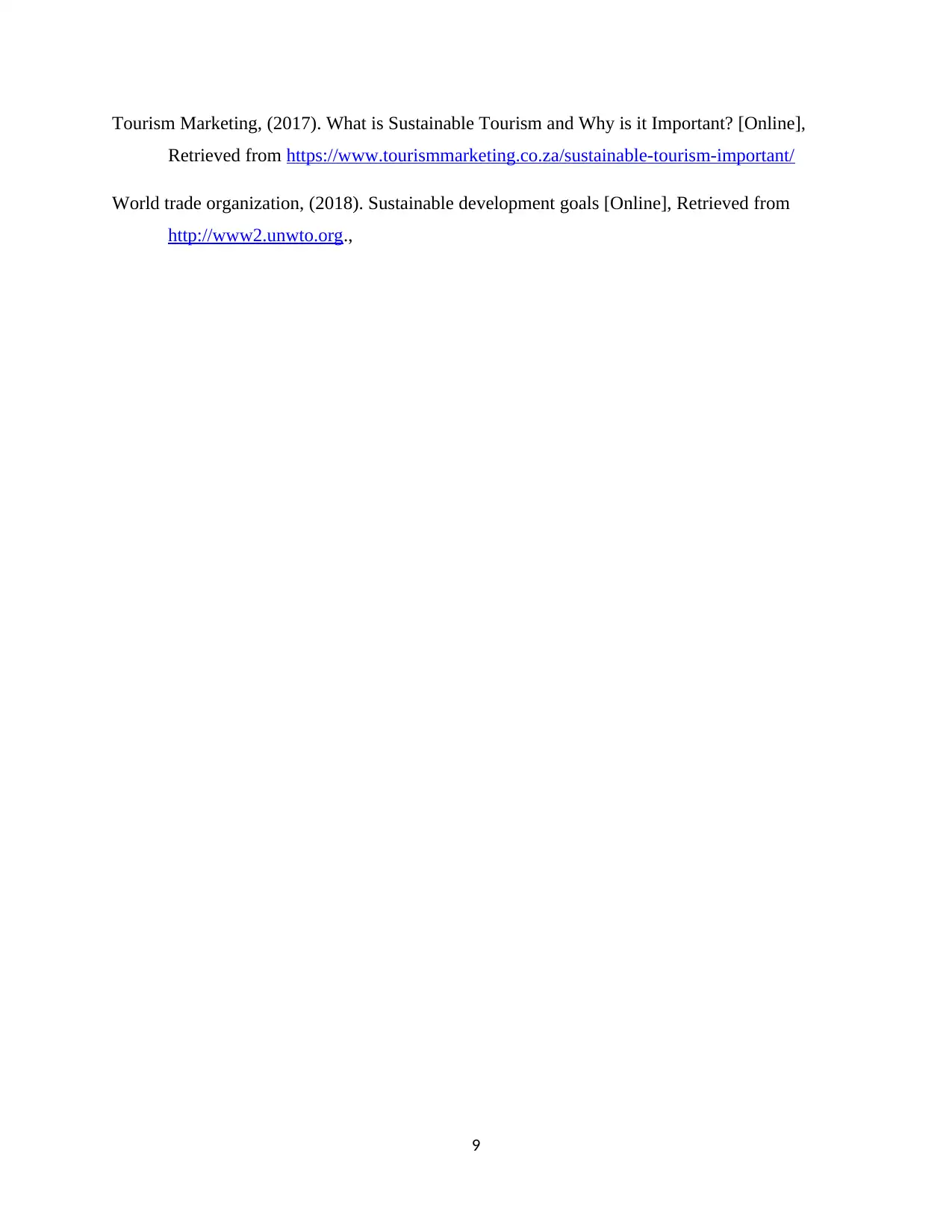
Tourism Marketing, (2017). What is Sustainable Tourism and Why is it Important? [Online],
Retrieved from https://www.tourismmarketing.co.za/sustainable-tourism-important/
World trade organization, (2018). Sustainable development goals [Online], Retrieved from
http://www2.unwto.org.,
9
Retrieved from https://www.tourismmarketing.co.za/sustainable-tourism-important/
World trade organization, (2018). Sustainable development goals [Online], Retrieved from
http://www2.unwto.org.,
9
1 out of 9
Related Documents
Your All-in-One AI-Powered Toolkit for Academic Success.
+13062052269
info@desklib.com
Available 24*7 on WhatsApp / Email
![[object Object]](/_next/static/media/star-bottom.7253800d.svg)
Unlock your academic potential
© 2024 | Zucol Services PVT LTD | All rights reserved.




